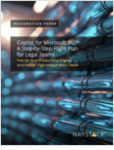The New York state department of Taxation and Finance, in an attempt to resolve a glaring discrepancy in the application of New York’s mortgage recording tax exemption to certain reverse mortgage borrowers, recently issued a new and lengthy advisory opinion which it apparently hoped would put the issue to rest — finally. Unfortunately, like Halloween 87 or Saw 43, the umpteenth sequel to a bad Hollywood franchise, the attempt to put the past in context did little to resolve the confusion. The problem is that senior citizens who convey their real property to a revocable, living or inter vivos trust receive a different mortgage recording tax treatment than senior citizens who convey their property outright to other persons (remainder persons who are generally family members) while retaining a life estate. In the former, the department had opined that the trust borrower qualified for the mortgage tax exemption (See The Edna Huff Trust, Adv Op Comm T&F, May 22, 1996, TSB-A-96(4)R)) whereas in the second situation, the life tenant borrower qualified for the exemption only if the persons holding the remainder interest also qualified for the tax exemption (See William H. Bradt, Adv Op Comm T&F, July 19, 2004, TSB-A-04(2)R)). To be a senior citizen under state statute, a person has to be 60 years of age or older. Therefore, we had the odd situation, at least under a superficial examination, that a person 60 years or older could put their property in a trust and still qualify for a mortgage tax exemption upon the recording of a reverse mortgage even when the beneficiaries were under the age of 60 whereas the person who conveyed his or her property to his or her children while retaining a life estate would qualify for the exemption only if the children were also over 60 years of age.
Under a reverse mortgage, a borrower, who must be at least 60 or 62 years of age depending upon the program, receives a payment from a lender as opposed to making payments to the lender. The borrower, in effect, mortgages the equity that the borrower has in his or her home. The borrower can use the payments from the lender for any number of purposes from paying off the existing mortgage to buying a Winnebago to travel across the country. Despite the fact that the costs for taking out a reverse mortgage are high, from 5 to 7 percent of the loan’s face amount, and that the interest on the loans is negatively amortized (accrued interest is added to the loan’s principal which means that the amount owed increases over time), such mortgages are becoming increasingly popular.[FOOTNOTE 1] Undoubtedly, support from the American Association of Retired Persons (“AARP”) and Robert Wagner’s ubiquitous commercials on cable television have much to do with the increase. Under New York Law, reverse mortgage borrowers who meet certain requirements are exempt from having to pay the mortgage recording tax. Since the mortgage tax rate can range from $1.25 in most counties to $2 per $100 in New York City, the savings gained under the exemption can be substantial. On a typical $300,000 reverse mortgage, the borrower would save from $3,750 in most counties to $6,000 in the city.





